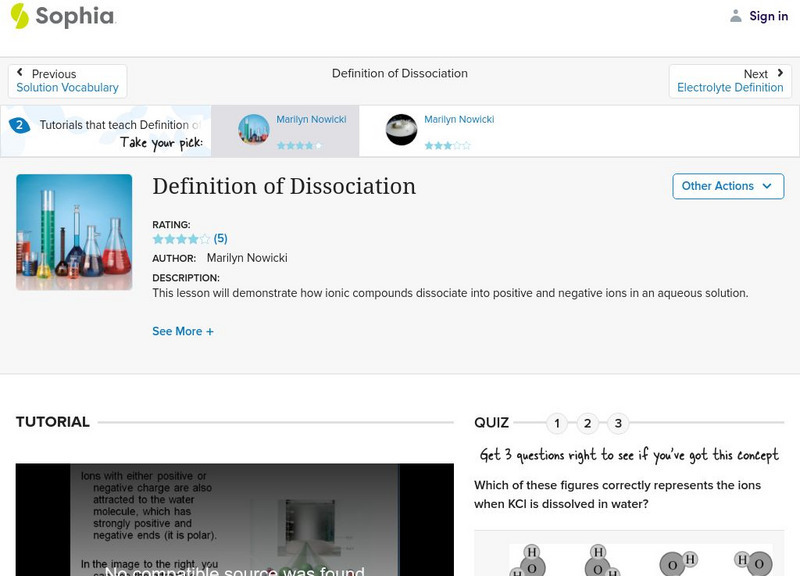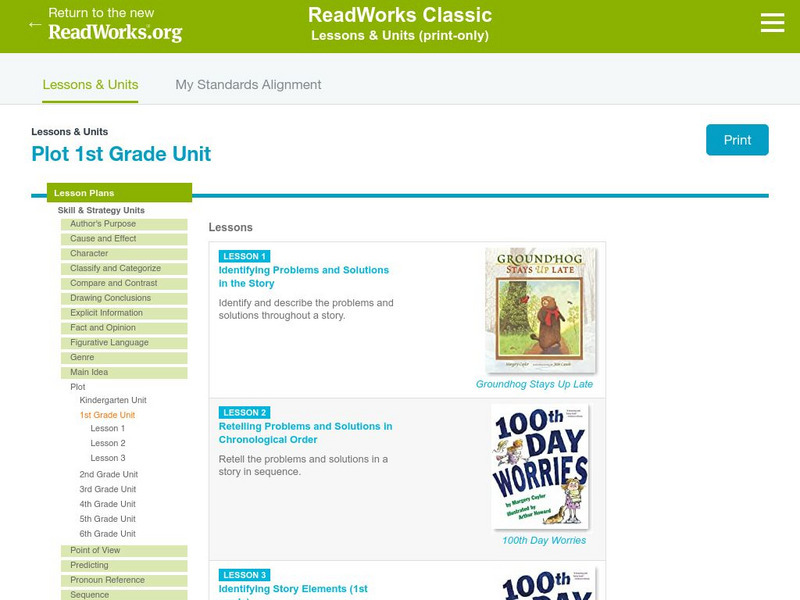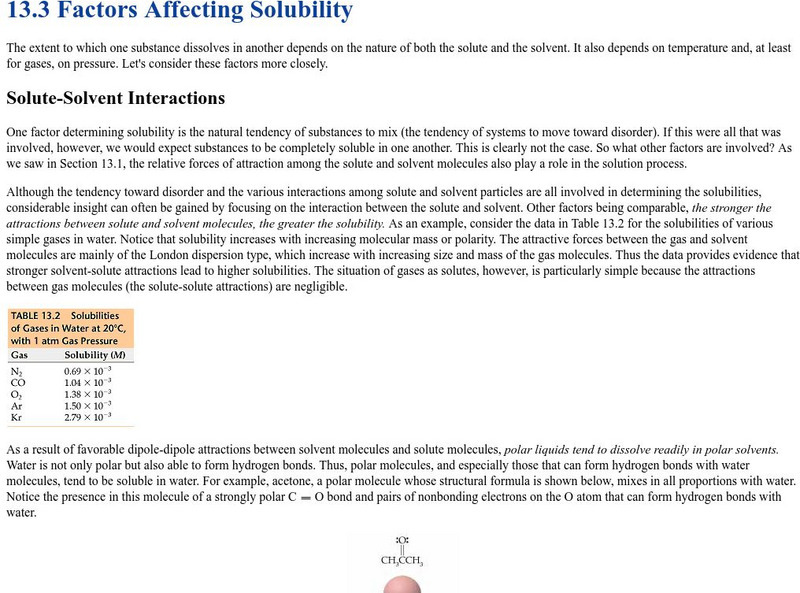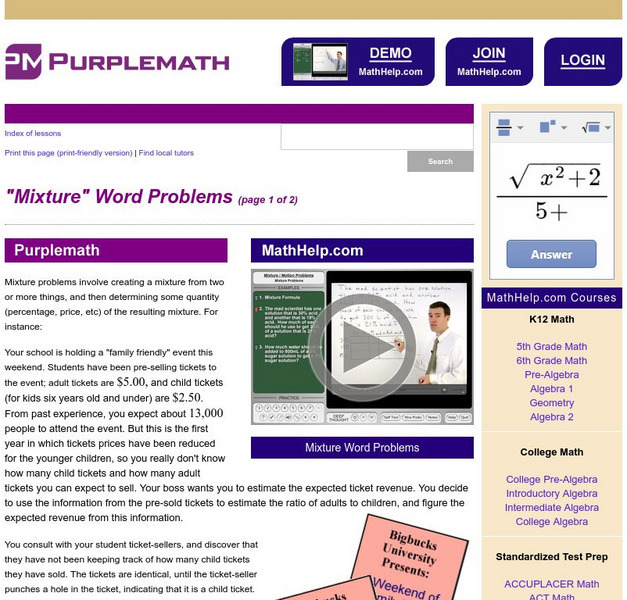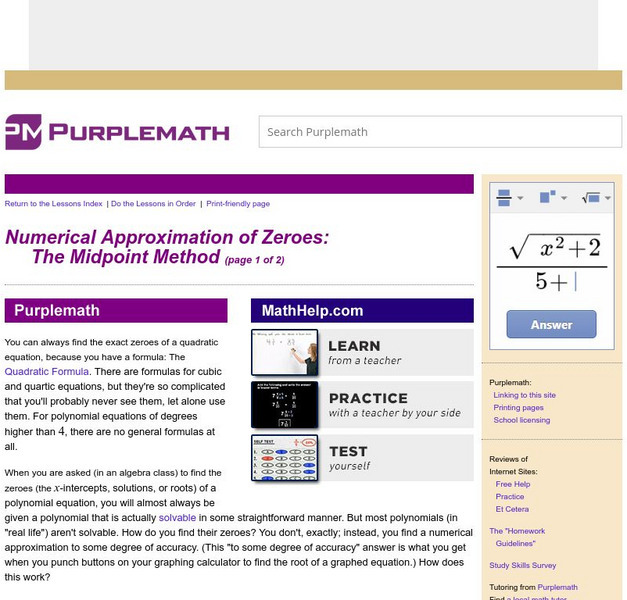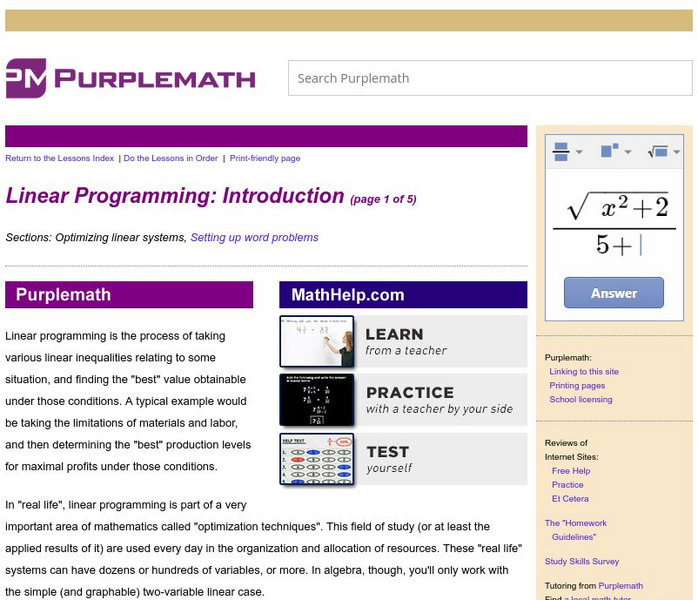CK-12 Foundation
Ck 12: Algebra: Checking Solutions to Inequalities
[Free Registration/Login may be required to access all resource tools.] On this site students learn to verify that solutions to inequalities are correct. Students can watch video tutorial, look at key vocabulary and attempt practice...
Sophia Learning
Sophia: Definition of Concentration
A narrated screencast which defines concentration, and illustrates some examples of different concentrations of solutions. [1:42]
Sophia Learning
Sophia: Definition of Dissociation
Find out how ionic compounds dissociate into positive and negative ions in an aqueous solution. [1:59]
Sophia Learning
Sophia: Molarity Calculations
A quick tutorial demonstrating how to figure the molarity of a solution.
Sophia Learning
Sophia: Null Set / Empty Set
This video lesson defines the phrase null or empty set. Students can check their understanding with an assessment.
Read Works
Read Works: Plot 1st Grade Unit
[Free Registration/Login Required] A series of three lesson plans designed to teach students to identify problems and solutions in fiction text and to retell a story's problem and solution in sequence. Students learn to identify the plot...
TeachEngineering
Teach Engineering: Mix It Up
This lesson plan introduces the properties of mixtures and solutions. A class demonstration gives the students the opportunity to compare and contrast the physical characteristics of a few simple mixtures and solutions. Students discuss...
Savvas Learning
Pearson Education: Factors Affecting Solubility
Learn how the extent to which one substance dissolves in another depends on the nature of both the solute and the solvent.
Chem Tutor
Chem Tutor: Dissolving Gases Into Liquids
Description of the factors influencing gas solubility. This site also provides other chemistry related questions. Topics include dissolving solids into liquids, concentration, and stoichiometry.
Purple Math
Purplemath: Systems of Non Linear Equations: Definitions
This Purplemath lesson provides formulas, equations, graphs and explanations of systems of equations.
Purple Math
Purplemath: Systems of Linear Equations: Definitions
Covers the basic definitions involved in systems of linear equations.
Purple Math
Purplemath: "Mixture" Word Problems
Demonstrates, step-by-step and with examples, how to set up and solve 'mixture' word problems.
Frostburg State University
University of Frostburg: How Nonpolar Molecules Dissolve
This site from the University of Frostburg provides an explanation of the process by which nonpolar molecules dissolve in water.
Frostburg State University
Frostburg State University: Polar Solutes
Graphic representing polar solute particles, with brief accompanying notes. Part of a slide show on chemical change.
Purple Math
Purplemath: Numerical Approximation of Zeroes: The Midpoint Method
Explains the reasoning and methodology for the process of numerically approximating the zeroes of a non solvable polynomial.
Quizlet
Quizlet: Story Elements (1St Grade): Test
Students will be asked 10 questions about story elements on this test. Six multiple choice and five true/false questions appear on this assessment. A printable version of this assessment is also available. Picture cures are provided next...
Quizlet
Quizlet: Story Elements (1St Grade) Match
This interactive game of "Match" assesses students' knowledge of story element definitions. Students will match the correct definition of a story element to its corresponding definition. Picture cues are provided on this review resource.
Purple Math
Purplemath: Linear Programming: Introduction
Linear programming is a part of a very important area of mathematics called "optimization techniques". This field of study (or at least the applied results of it) are used every day in the organization and allocation of resources. Linear...
California State University
California State University: Crystallization and Solution
This site from the California State University provides good information on the crystallization of a supersaturated solution. The article is not too in-depth, and several pictures are provided along with a short movie on the subject.
University of Georgia
University of Georgia: Inter Math: Linear Equation
This site defines a linear equation in a very basic and understandable way. The opening page gives examples of linear equations and questions posed to the reader which may be answered easily by examining the definition given. Be sure to...
CK-12 Foundation
Ck 12: Physical Science: Solutions
[Free Registration/Login may be required to access all resource tools.] What a solution is and its different parts, definition of soluble and insoluble. Solutions in different states of matter.
Chem Tutor
Chem Tutor: Concentration
An overall summary of the major units of the concentration of a solution, including normality.
CK-12 Foundation
Ck 12: Fifth Grade Science: Physical Science: Rate of Dissolving
[Free Registration/Login may be required to access all resource tools.] Discusses the rate of dissolving and the factors that affect it.
CK-12 Foundation
Ck 12: Fifth Grade Science: Physical Science: Separating Mixtures
[Free Registration/Login may be required to access all resource tools.] Discusses how mixtures of solids can be separated based on observable properties of their parts such as particle size, shape, color, and magnetic attraction.




